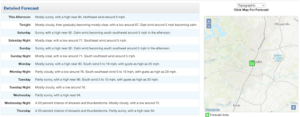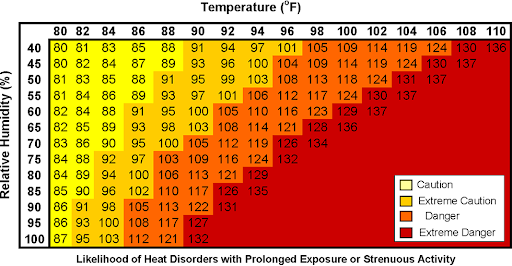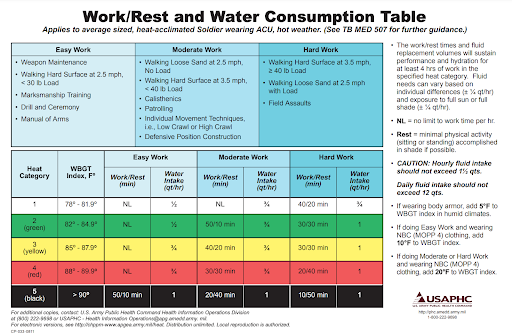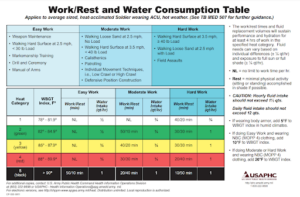
Learn the signs of heat-related illness. (See below)
Use the heat tracker to stay informed.
Insulate old windows with bubble wrap.
Curtains or blinds can help block the sun and keep the house cooler.
Find places in your town where you can go to cool off, like libraries or malls. You can also ask the local health office where there’s a cooling center nearby.
To get a forecast from the National Weather Service (English only) in your exact location, go to the page for Austin/San Antonio, and scroll down to this section. Click your exact location on the map and see the detailed forecast change for your area.

Call to make arrangements so your electricity doesn’t cut off.
Place the fan facing out to remove hot air from the house.
Weather.gov shows that temperatures inside a car will reach 100° in 25 minutes. Cracking a window helps a little, but even with a cracked window, in 90° the car interior can reach a dangerous 110° in 10 minutes and reach over 130° in under 50 minutes.
How much water should you drink when outside in the heat? It varies by body weight, but there are some general guidelines. The CDC recommends that when working in the heat, people drink about one quart of water per hour. The US Army utilizes a work/rest and water intake chart that shows varying recommendations by heat category. Similar to the CDC, the chart recommends that while doing easy work on a day with extreme heat (above 90°), 1 quart per hour is recommended. This leaves us with at least 2 gallons of water per day per individual.
Austin regularly designates certain libraries and rec centers as cooling centers throughout the summer. The map can be found here.
Cool showers can help lower body temperature quickly.
Loose, lightweight clothing helps keep the body ventilated and cool.
Ovens can continue to emit extra heat hours after use.
Wearing a hat can help avoid moisture loss and also share the face and hear, where heat can be lost.
Elderly individuals, children, and those with chronic illnesses are particularly susceptible to the effects of heat and may suffer from delayed health issues like dehydration or heat exhaustion. Ensure those affected by heat-related illnesses receive proper medical care. This might include hydration therapy, treatment for heatstroke, or regular health check-ups in the days following the heat wave.
Use a big fan in your attic to help push out the hot air and cool down your house.
Elderly individuals, children, and those with chronic illnesses are particularly susceptible to the effects of heat and may suffer from delayed health issues like dehydration or heat exhaustion. Ensure those affected by heat-related illnesses receive proper medical care. This might include hydration therapy, treatment for heatstroke, or regular health check-ups in the days following the heat wave.
Provide mental health support: The stress and potential isolation due to extreme heat can have psychological effects. Offering community mental health services can help those who might be struggling.
Prolonged heat can damage roads, power lines, and other infrastructure.
Plants, lawns and trees can be severely impacted by prolonged heat and drought.
If it’s hard to pay for keeping your house cool, ask for help from the Low Income Home Energy Assistance Program (LIHEAP). They help with costs and fixing things at home to save energy
Cooling towels can be purchased at most major stores like Walmart and outdoor stores. They can be activated with water and help cool the skin.
Improve insulation to keep the heat out and cool air in. Use shades, curtains, or reflective film on windows to reduce heat entering your home.
Designate one or two rooms to keep the coolest. Use fans and portable coolers if necessary.
Wear lightweight, loose-fitting, and light-colored clothing. A wide-brimmed hat can protect you from direct sunlight. Cotton and linen are excellent, breathable fabrics for heat.
Be aware of symptoms of heat-related illnesses such as heat exhaustion and heat stroke. Symptoms include heavy sweating, weakness, dizziness, nausea, and a rapid pulse.

Heat-Related Illness | Symptoms and Signs |
Heat stroke |
|
Heat exhaustion |
|
Heat cramps |
|
Heat syncope |
|
Heat rash |
|
Rhabdomyolysis (muscle breakdown) |
|
Source: Osha.gov |


People under the age of 5 have less ability to regulate their body temperature. As a result, younger children are at higher risk of heat-related illness and death. Watch for signs of heat-related illness and keep children indoors during the hottest times of day.
People over the age of 65 have less ability to regulate their body temperature. As a result, older adults are at higher risk of heat-related illness and death. Stay inside during the hottest parts of the day, and drink plenty of water.
Make sure your mobility tools are ready and working. Keep extra batteries for any powered equipment in a waterproof bag. Try to have someone you can call for help in an emergency.
Women who are pregnant are also at higher risk of dehydration and heat-related illness. Overheating can not only cause harm to pregnant women, but the to the health of the fetus as well. Drink plenty of water, avoid exertion in the hottest times of day, and consult a doctor with questions.
Make sure your pet has extra water during the hottest times of the season. You may want to bring pets indoors.
Be extremely careful. Weather.gov shows that temperatures inside a car will reach 100° in 25 minutes. Cracking a window helps a little, but even with a cracked window, in 90° the car interior can reach a dangerous 110° in 10 minutes and reach over 130° in under 50 minutes.
Family Eldercare is conducting it’s Summer Fan Drive, with a goal of getting 10,000 fans to home this summer.
Keep a list of your medicines and enough for at least a week. Put them in a waterproof container. Have a cooler ready for medicines that need to be kept cold.
Sign up for emergency alerts that show messages on your phone or computer. Keep extra batteries for any devices you use. Let emergency workers know that you need visual alerts.
Have your cane or guide dog’s harness ready in case you need to leave quickly. Mark your supplies so you can tell what they are by touching or feeling them. Make sure you can get alerts through sound or vibration.
Learn about buses and trains you can use in an emergency. Find someone nearby who can give you a ride if you can’t use public transport.
Make an emergency kit for the person you take care of. Include their special foods and medical supplies. Plan what to do if you can’t get to them.
Contact your utility provider about a payment plan. Most companies will allow for payment plans, especially during the hottest months.
Use the work, rest and water table to help keep you safe during outdoor work activities.
Find out which local services give information in your language. You can use translation apps on your phone that work even when you’re not online.
Keep all your health stuff like prescriptions and insurance information in one place. Have enough medicine and special food ready.
Know where shelters are and what you need to get in. Keep your important papers like ID in a waterproof bag. Keep a bag with food, water, and a first aid kit. Stay clean to avoid getting sick.Stay up to date on where to go when it floods.
Sign up for CTOSH and the Homeless Texting Alert System
If your apartment does not have air conditioning, you may have more power than you think. Try contacting 311 or your city council member for support.
According to the US Energy Information Administration, 5% of homes in Texas do not have conditioning, and 16% do not have central air conditioning. If these statistics hold true at the county level, that would be roughly 66,000 people without air conditioning, and an additional 211,200 people using window units. The CDC recommends that when working in the heat, people drink about one quart of water per hour. The US Army utilizes a work/rest and water intake chart that shows varying recommendations by heat category. Similar to the CDC, the chart recommends that while doing easy work on a day with extreme heat (above 90°), 1 quart per hour is recommended.